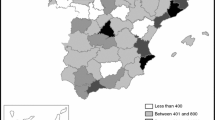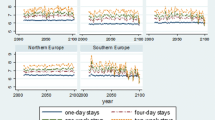Abstract
This paper investigates how the role of climate in tourist destination choice has changed over the last 15 years. To this end, a demand model for international tourism is estimated, including the main classic determinants but allowing a time-varying climatic sensitivity of tourists. Moreover, a complete database considering international tourism movement between 178 countries for the period 1995 to 2010 is used. Results show how turning point temperatures in origin and destination countries have changed over the period of analysis, evidencing a loss of competitiveness for traditional warm destinations. Additionally, using data for the projected growth of Gross Domestic Product per capita and climatic conditions within A2, B1 and B2 scenarios, an updated vision of their expected impact on international tourism flows is assessed, evaluating how climate change would imply a greater loss of attractiveness for traditional warm destinations around the world but would increase attractiveness for high latitude countries.



Similar content being viewed by others
Notes
Cloud coverage was initially considered, but it turned out to be non-significant when temperature and precipitation were considered, so it was dropped from the final model
It is true that it seems to be implausible for tourists from origin countries with a large coastline to travel more; however as expected, the impact of the magnitude of the coastline in the destination country is larger than the magnitude in the origin one. Moreover, this result indicates that a large coastline per se does not imply more tourism, but rather that good weather is also required. Hence, warm countries with long coastlines are the most preferred tourist destinations.
References
Amelung B, Nicholls S, Viner D (2007) Implications of global climate change for tourism flows and seasonality. J Trav Res 45:285–296
Anderson JE (1979) A theoretical foundation for the gravity equation. Am Econ Rev 69:106–116
Anderson JE, van Wincoop E (2003) Gravity with gravitas: a solution to the border puzzle. Am Econ Rev 93:170–192
Bergstrand JH, Egger P (2007) A knowledge-and-physical-capital model of international trade, foreign direct investment, and foreign affiliates sales: developed countries. J Int Econ 73:278–308
Bigano A, Hamilton JM, Maddison DJ, Tol RSJ (2006a) Predicting tourism flows under climate change an editorial comment on Gössling and Hall. Clim Chang 79:175–180
Bigano A, Hamilton J, Tol RSJ (2006b) The impact of climate holiday destination choice. Clim Chang 76:389–406
Brun J, Carrere C, Gillaumont P, de Melo J (2005) Has distance died? evidence from a panel gravity model. World Bank Econ Rev 19:99–120
Bujosa A, Rosselló J (2013) Climate change and summer mass tourism: the case of Spanish domestic tourism. Clim Chang 117:363–375
CEPII (2012) Gravity dataset. Retrieved from http://www.cepii.fr/anglaisgraph/bdd/gravity.asp
CIA (2012) The World Factbook. Central Intelligence Agency, Washington, DC. Retrieved from https://www.cia.gov/library/publications/the-world-factbook/
Eugenio-Martin JL, Campos-Soria JA (2010) Climate in the region of origin and destination choice in outbound tourism demand. Tour Manage 31:744–753
Fourie J, Santana M (2011) The impact of mega-events on tourist arrivals. Tour Manage 32:1364–1370
Gil-Pareja S, Llorca R, Martínez JA (2006) The impact of embassies and consulates on tourism. Tour Manage 28:355–360
Gil-Pareja S, Llorca R, Martínez JA (2007) The effect of EMU on tourism. Rev Int Econ 15:302–312
Goh C (2012) Exploring impact of climate on tourism demand. Ann Tourism Res 39:1859–1861
Gössling S, Hall C (2006) Uncertainties in predicting tourist flows under scenarios of climate change. Clim Chang 79:163–173
Hamilton J, Tol RSJ (2007) The impact of climate change on tourism in Germany, the UK and Ireland: a simulation study. Reg Environ Change 7:161–172
Hamilton J, Maddison D, Tol RSJ (2005a) The effects on climate change on international tourism. Climate Res 29:245–254
Hamilton J, Maddison D, Tol RSJ (2005b) Climate change and international tourism: a simulation study. Glob Environ Chang 15:253–266
Head K, Ries J (2008) FDI as an outcome of the market for corporate control: theory and evidence. J Int Econ 74:2–20
IPCC (2001). Special Report on Emissions Scenarios (SRES). Retrieved from http://www.grida.no/publications/other/ipcc_sr/
Kandogan Y (2008) Consistent estimates of regional blocs, trade effects. Rev Int Econ 162:301–314
Kimura F, Lee HH (2006) The gravity equation in international trade in services. Rev World Econ 142:92–121
Lise W, Tol RSJ (2002) Impact of climate on tourism demand. Clim Chang 55:429–449
Maddison D (2001) In search of warmer climates? the impact of climate change on flows of British tourist. Clim Chang 49:193–208
Moreno A, Amelung B (2009) Climate change and tourist comfort on Europe’s beaches in summer: a reassessment. Coast Manag 37:550–568
Morley CL (1992) A microeconomic theory of international tourism demand. Ann Tourism Res 19:250–267
Scott D, Mcboyle G, Mills B (2003) Climate change and the skiing industry in southern Ontario (Canada): exploring the importance of snowmaking as a technical adaptation. Climate Res 23:171–181
Scott D, Mcboyle G, Minogue A (2007) Climate change and Quebec’s ski industry. Glob Environ Chang 17:181–190
Scott D, Gössling S, Hall CM (2012) International tourism and climate change. Wiley Interdiscip Rev Clim Chang 3:213–232
Shaw W, Loomis JB (2008) Frameworks for analyzing the economic effects of climate change on outdoor recreation. Climate Res 36:259–269
Song H, Li G (2008) Tourism demand modelling and forecasting -a review of recent research. Tour Manage 29:203–215
Tol RSJ, Walsh S (2012) The Impact of Climate on Tourist Destination Choice. Working paper: ERSI. Economic and Social Research Institute, Dublin
UN-WTO (1995) Concepts, Definitions, and Classifications for Tourism Statistics - Technical Manual No. 1. United Nations World Tourism Organization. Retraived from http://pub.unwto.org/WebRoot/Store/Shops/Infoshop/Products/1033/1033-1.pdf
UN-WTO (2012) Tourism Factbook Database. Retraived from http://www.wtoelibrary.org. (Available under subscription)
Vietze C (2012) Cultural effects on inbound tourism into the USA: a gravity approach. Tourism Econ 18:121–138
WTTC (2012) Travel & Tourism Economic Impact 2012. WTTC, World Travel and Tourism Council. London. Retrieved from: http://www.wttc.com
Acknowledgements
We would like to thank Richard S.J. Tol (Sussex University, UK) for helpful comments, and suggestions about data sources provided by Fabio Eboli (Fondazione Eni Enrico Mattei, Italy). Financial support from the CICYT Program (Spanish Government) through grants ECO2010-22143 and ECO2011-23189, and the VI Framework Program through the CIRCE project (003933-2) is gratefully acknowledged. Finally, we want to thank UN-WTO for kindly providing us with tourism data.
Author information
Authors and Affiliations
Corresponding author
Electronic supplementary material
Below is the link to the electronic supplementary material.
ESM 1
(DOC 331 kb)
Rights and permissions
About this article
Cite this article
Rosselló, J., Santana-Gallego, M. Recent trends in international tourist climate preferences: a revised picture for climatic change scenarios. Climatic Change 124, 119–132 (2014). https://doi.org/10.1007/s10584-014-1086-3
Received:
Accepted:
Published:
Issue Date:
DOI: https://doi.org/10.1007/s10584-014-1086-3




